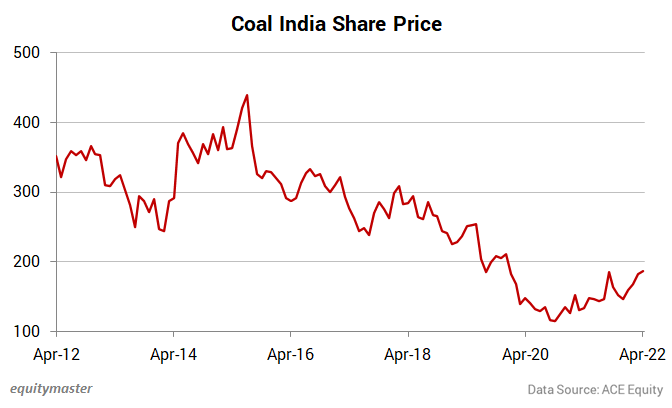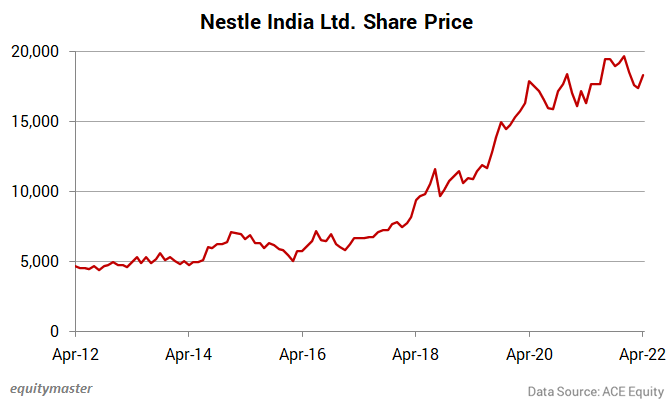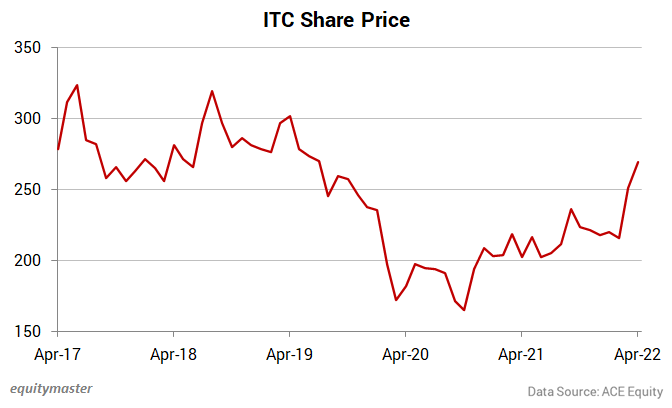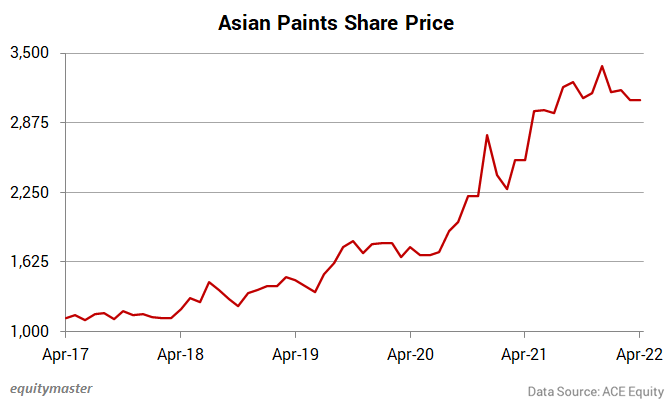India's Third Giant Leap
This Could be One of the Biggest Opportunities for Investors
- Home
- Views On News
- Apr 19, 2022 - Good Monopoly Stocks vs Bad Monopoly Stocks
Good Monopoly Stocks vs Bad Monopoly Stocks
In July 2021, we introduced you to the top 4 companies that are strong monopolies. Since then, we have written about some more monopoly or near-monopoly stocks.
Along with the stocks, these articles explicated the idea of bad (or say risky) monopoly stocks.
Contrary to popular belief, all monopoly stocks are not risk-free investments. Rather, some can single-handedly drag down the returns of your portfolio.
Look at the share price charts of two well-known monopolies in India: Coal India and Nestle.


Coal India is the largest producer of coal in the world. In the fiscal year 2021, it accounted for 83% of total coal production in India.
On the other side is Nestle. It has the Cerelac in its umbrella. It's a market leader (96.5% market share) in the baby food segment.
Despite having a monopoly, shares of Coal India that once traded at Rs 350 (in 2010), now trade at Rs 186. Nestle's shares grew over 600% from 2010.
So how does one differentiate between good monopoly stocks and bad monopoly stocks?
Here are some points that can help you do just that...
#1 Avoid expensive PSU stocks
Primarily, the purpose of a PSU is to serve the country.
In spite of having a competitive edge, these companies don't thrive on profits.
A classic example is Air India.
In its mission to expand accessibility, the company operated many loss-making routes, some with less than 30% occupancy. This brought massive debt on its books.
Similarly, PSU banks build and operate unlucrative branches in remote areas for network extension. This hampers overall profitability.
While providing ease of access is great from a social perspective, it does little in generating returns for an investor.
#2 Avoid stocks with limited/uncertain growth prospects
The company's share price depends more on future profitability than current profits. This is heavily dependent on exploring the available growth prospects.
Controlling the market space within an industry does not implicate strong growth. Look at Bharat Heavy Electricals Limited's (BHEL) revenue and profit for the past decade.
| Year | 2012 | 2013 | 2014 | 2015 | 2016 | 2017 | 2018 | 2019 | 2020 | 2021 |
|---|---|---|---|---|---|---|---|---|---|---|
| Revenue (in Rs bn) |
502.6 | 503.3 | 404.5 | 311.0 | 276.0 | 284.5 | 289.3 | 304.2 | 214.6 | 173.1 |
| Net Profit (in Rs bn) |
70.4 | 66.1 | 34.6 | 14.2 | -7.1 | 5.0 | 8.1 | 12.1 | -14.7 | -27.2 |
BHEL is the largest power generation equipment manufacturer in India. It's also a market leader in the emission control equipment business.
Though BHEL features on the list of monopolies, its sales growth has been negative for many years.
Being a PSU worsens the situation. BHEL is not incentivised to increase prices, bag more contacts or cut down costs.
Growth uncertainty can also be found in private companies like ITC. Even after diversifying into FMGC and hotel industries, most of the profits come from the cigarettes segment.
This segment is highly sensitive to taxation thus having unclear growth prospects.
Owing to this ambiguity, shares of ITC haven't moved that much in spite of posting strong performance over the years.

#3 Avoid high government intervention sectors
While government policies help create some monopolies, high intervention can change the entire valuation of the company.
In October 2021, the ministry of railways asked IRCTC to share with it 50% of revenues collected as convenience fees. The decision was reversed the following day.
But the share price took a dive as investors recognised the level of influence the government had over IRCTC.
Another example is Hindustan Aeronautics (HAL), the only monopoly company in the defense sector.
Regardless of performing well in the share market, the fate of the company highly depends on the government.
Another example is Coal India. Shares of Coal India came under intense pressure when the government announced commercial mining of coal by the private sector. This ended the government's long monopoly in coal sector.
Government also hampers the profitability of PSUs by restricting employee termination, hindering workforce rationalisation.
#4 Avoid cyclical monopolies
Similar to other companies, monopolies can also be cyclical.
Take an example of Coal India.
It's the largest producer of coal in the world but the entire business is subject to the amount of coal mined.
Coal is a natural resource with perishable reserves. The amount of coal imported also impacts the necessity to mine.
Global anomalies like the Russia-Ukraine war also impact the profitability (though it is positive in this case) of such companies.
#5 Look for companies with strong moats
A strong economic moat protects market share from competitors and boosts long-term profitability.
A case in point: Asian Paints.
It has been a market leader for four decades in the organised paint industry. The product mix along with strong distribution channels cater to its global presence in 17 nations.
In the early years, the company invested heavily in technology to collect and corroborate the demands of its consumers.
Today, the company with 97% accuracy, can predict the amount and color of paint needed in any outlet at any given time.
Combining this with a distribution network twice the size of its nearest competitor. It has created an unbreachable moat.
No wonder, its share price has almost tripled in half a decade.

#6 Look for companies with clear growth paths
It is very simple - Profits = Revenue - Cost.
To stay profitable, a company must either increase revenue or decrease cost.
This can be achieved by expanding the product range or integrating the production process.
Take Pidilite Industries for example. Its product Fevicol is synonymous with adhesives in India.
The company kept extending its product line with brands like Fevikwik, Dr. Fixit, M-seal, and many more.
Pidilite launched Hobby Ideas, India's first chain of art and craft offering cheaper alternatives to imported overpriced products.
This shows the company's desire to exploit growth opportunities, making it an investable choice.
#7 Look for monopolies that yearn for profits
Most private companies are in the business to make profits. When the company generates good return, you make money as an investor.
Nestle India presents a perfect model.
Nestle's brand Maggi (instant noodles) has no close competitors. Even then, the company indulges in market research to be in line with the ever-evolving tastes of consumers.
This clearly portrays that the company is not ready to lose market share or accept lower margins which hurt its profitability in the long run.
So are monopolies the same as other companies?
Yes and no.
In addition to general criteria like industry analysis, business scope, intrinsic value, financial stability, profit margins, etc, focus on moats while evaluating monopolies.
Moats can be formed in numerous ways: cost advantage, intangible assets like patents, brands, and licences, switching costs, efficient scale of operations, etc.
One key parameter is to understand the scalability of such moats.
Some moats depend on external factors like government policies which tend to change with time. This should be taken into consideration while investing in them.
The wider the moat, the stronger the business. If the moat is weak, ultimately competition will come in, erode returns, and take away market share and profits.
Hence, a smart way to invest is to pick companies with strong moats.
Happy Investing!


Equitymaster requests your view! Post a comment on "Good Monopoly Stocks vs Bad Monopoly Stocks". Click here!
Comments are moderated by Equitymaster, in accordance with the Terms of Use, and may not appear
on this article until they have been reviewed and deemed appropriate for posting.
In the meantime, you may want to share this article with your friends!